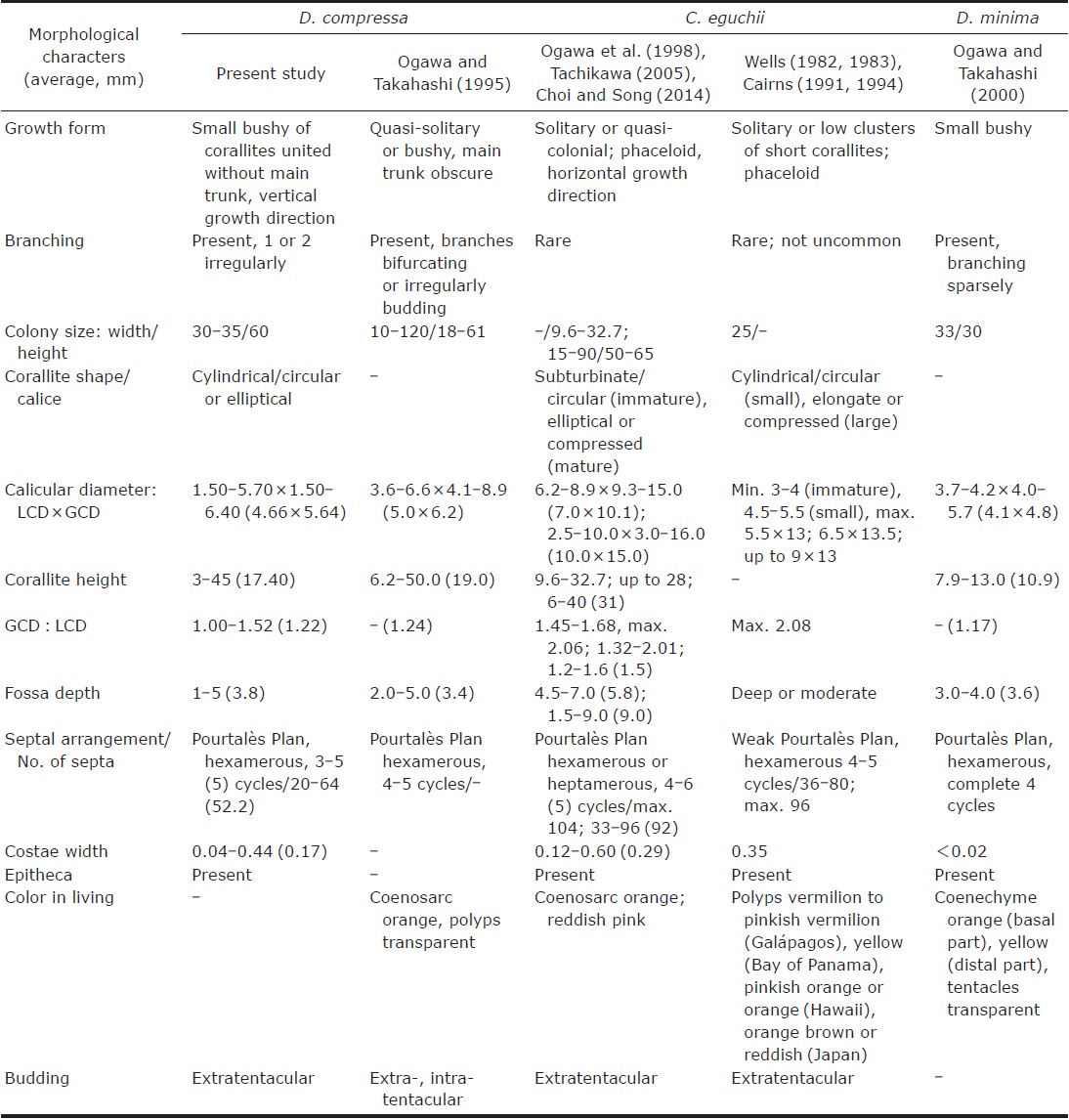



The family Dendrophylliidae Gray, 1847 comprises 167 species in 21 genera (Cairns, 2001; Roberts et al., 2009; World Register of Marine Species, 2015). Among these species, 29 species in the genus
The specimen was collected from the subtidal zone off Seogwipo, Jeju-do, Korea in 1969. It was dissolved in sodium hypochlorite solution diluted with distilled water for 24 hours to remove all the soft tissues, washed in distilled water, and dried for the examination of the skeletal structures. The external growth forms and shapes of the coralla were photographed with a digital camera (D7000; Nikon Corp., Tokyo, Japan). The internal skeletal structures of the corallites were examined under a stereomicroscope (Leica S8APO; Leica Microsystems, Wetzlar, Germany), photographed with a mounted camera (Leica Microsystems), and measured with an image analyzer (LAS ver. 3.6; Leica Microsystems). Multi-focused photographs were taken and combined by an image editing program (HeliconFocus 5.3 Pro; Helicon Soft Ltd., Kharkov, Ukraine) to obtain clear images of the skeletal structures. The classification of scleractinians and the morphological terms in the present study are referenced from Wells (1956), Cairns (1994, 2001), and Cairns and Kitahara (2012). The examined specimen is deposited at the Ewha Womans University Natural History Museum, Korea. The following abbreviations are used: C, costal cycle; GCD, greater calicular diameter; LCD, lesser calicular diameter; GCD : LCD, ratio of greater calicular diameter to lesser calicular diameter; S, septal cycle.
Diagnosis. Synapticulotheca developed. Septa composed of one fan system. Pourtalès Plan present.
Diagnosis. Colonial, attached. Extratentacular budding. Growth form monopodial and arborescent or bushy or sympodial. Costae usually well defined with small granules. Pourtalès Plan developed. Pali present or absent. Columella spongy or papillose.
>
[Table 1.] Morphological characters of Dendrophyllia compressa

Morphological characters of Dendrophyllia compressa
Material examined. Korea: Jeju-do: 1 ind., Seogwipo-si, off Seogwipo, 14 Dec 1969, Rho BJ (EWZS 4113).
Description. Corallum colonial, attached. Growth form bushy, corallites loosely united without main trunk, 30-35 mm in width, 60 mm in height. Growth direction vertical. Extratentacular budding. Branching once or twice irregularly. Corallites (fully grown) cylindrical with 3.79-5.70× 4.88-6.19 (minimum 1.5×1.5) mm in calicular diameter (GCD : LCD 1.04-1.47), 8-45 mm in height. Axial corallites 3.46-4.92×4.95-6.40 mm in calicular diameter (GCD : LCD 1.01-1.52), 15-45 mm in height. Lateral corallites 2.95-4.04×3.29-4.98 mm in calicular diameter (GCD : LCD 1.04-1.29), 3-8 mm in height. Calice compressed, elliptical or circular in fully grown corallites. Columella elliptical or circular, fully covered, flat, spongy or fascicular or papillose, 0.82-1.58×1.68-2.75 (minimum 0.35×0.52) mm in diameter. Fossa 3-5 (minimum 1) mm in depth. Theca synapticulotheca, defined with costae, intercostal striae. Costae granulated, 0.04-0.44 mm in width. C1>C2>C3 in width. Costal granules 0.02-0.24 mm in diameter. Intercostal striae indistinctively porous, 0.03-0.25 mm in width. Epitheca present in some corallites. Pourtalès Plan well developed. Septa hexamerously arranged with 46-64 (minimum 20) in 4-5 cycles. In 5 cycles, S1≥outer S5≥S2>inner S4>S3> inner S5>outer S4. Pairs of S5 united before common outer S4 and extended to inner S4. In 4 cycles, S1≥outer S4≥ S2>inner S4>S3. Pairs of S4 united before common S3. S1 fused with its neighboring outer S4 or outer S5, S2 fused with its neighboring inner S4 or outer S5, S3 fused with its neighboring inner S5 or none at outer thecal margins. S1, S2, outer S5 or outer S4 fused with columella. Septal upper margins of S1, S2, S3 exserted, 0.29-0.66 mm above theca. Inner edges of S1, S2 entire, vertical. Septal faces covered with small spines.
Ecology. Barnacles, tube worms, hydroids, oysters and bryozoans live in ectosymbiosis on the corallum of the species.
Remarks. The examined specimen in the present study agrees well with

Comparison of Dendrophyllia compressa, Cladopsammia eguchii, and Dendrophyllia minima morphological characters
On the other hand, Eguchi first reported this species as
Distribution. Pacific Ocean: Korea (Jeju-do); Japan (Southern Honshu).
Korean name:1*타원나무돌산호 (신칭) 1*The Article 45.5.1 of the International Code of Zoological Nomenclature states, “A name that has infrasubspecific rank cannot be made available from its original publication by any subsequent action (such as elevation in rank) except by a ruling of the Commission.... The subsequent author for the subsequent action thereby establishes a new name with its own authorship and date.”


